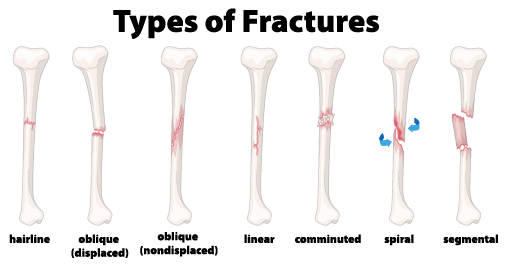Signs, Symptoms, and Treatment of Fractures
- Category: Health & Wellness
- Posted On:
- Written By: LVMC

Is a broken bone the same as a fracture? Knowing what to expect if you have a broken or fractured bone can make the healing process less stressful.
Bones play a pivotal role in your body. They help provide structure, protect your organs, anchor muscles, and store minerals like calcium. Knowing what to expect if you fractured a bone will help you better understand the healing process.
What Is the Difference Between a Broken Bone and a Fractured Bone?
A fracture and a broken bone are interchangeable terms used to describe the same thing. Both these terms mean that the bone has been shattered due to some excessive force. There are many different types of fractures, and most of them will require immediate medical treatment.
Causes of Fractures
Bone fractures usually occur due to three reasons: an external outside force greater than what a bone can handle, excessive bone stress, or weakened bones. External forces that can lead to fractured bones include automobile accidents, sports injuries, falls, or other external impacts.
Some fractures can result from repeated internal forces such as running. These result in small stress fractures known as hairline fractures. Bone integrity may also weaken from infections and even cancer. These conditions can then lead to fractures from minor falls or bumps.
As we get older, our bones get weaker. This is known as osteoporosis, which can lead to a higher risk of fractures.
Signs and Symptoms of Fractures
Bone fractures may or may not be obvious, and therefore you should watch for a variety of signs and symptoms. These usually depend on the severity of the fracture and where it is. Generally, the symptoms include pain, swelling, bruising, sudden malalignment of the bone, difficulty moving, or even numbness. You may also note a tender injured area or may feel warm.

Sometimes, a fractured bone may puncture through the skin, causing an open fracture, and you may see the bone through the skin.
If you suspect that you have a fracture, go straight to the emergency room to get it examined. Call the ambulance if you cannot walk, are in excruciating pain, or have multiple injuries.
How Are Fractures Diagnosed?
A healthcare provider will examine the injured area for movement and any possible fracture symptoms. Many fractures are usually diagnosed using X-rays.
Sometimes, depending on the type of fracture, the complexity, and indication, other imaging modalities may be used. A computer tomography scan (CT scan) can be used to provide a more detailed three-dimensional view of the fractured bone. Sometimes a special dye called contrast helps determine the physician if the blood vessels around the bone are affected.
Magnetic resonance imaging (MRI) may be ordered if the bone fracture is small or if the doctor is concerned that other structures like ligaments, tendons, or muscles have been injured or torn in the process.
Treatment of Fractures
The treatment of fractures depends on the type of fracture that you may have. Bones are constantly undergoing remodeling. That means that bone cells are constantly breaking down and building new bone, helping bones heal and repair the fracture.
Bone cells will start the healing process immediately after a fracture. As new bone is being remodeled, the cells bring the two edges close to each other. This is where orthopedists, or doctors who specialize in bones, use immobilization options to help protect the new soft bone tissue. These include but are not limited to:
- Splints: made of strips of fiberglass or plaster and used to immobilize a specific part of a joint or bone.
- Casts are made of fiberglass or plaster but are wrapped completely around the bone or joint injured to protect it.
- Slings: usually used for shoulder or clavicle injuries to allow the joint to rest while the joint heals.
- Combination of any of the previously mentioned treatments.
The orthopedist will ensure that the bone is realigned, meaning that the two broken ends are as close as possible to heal better.
- This process can be done without surgery, also known as a closed reduction. Still, it will often require pain medication and may even require sedation.
- An open reduction is when an orthopedist needs to operate on the broken bone and insert either pins, rods, or screws to approximate fractured bones. This will require anesthesia and pain management.
Optimizing Healing
Multiple factors affect the healing of broken bones, which is why it is important to follow your doctor’s treatment plan and take care of your bones.
Eating a healthy diet will optimize the healing process. Speak with your doctor about taking dietary supplements like calcium, Vitamin D, or Vitamin C if you have a fracture, as these may promote fracture healing.
Ceasing smoking any tobacco-containing product will help your bone heal faster since smoking increases the risk of poor healing and may delay the overall process.
Diabetes and obesity have also been shown to predispose to poor bone healing after fractures. That is why preventative care for these two conditions is key since diabetes and obesity also have other health risk factors.
How Long Does It Take for Fractures Heal?
The length of time for a fracture to heal depends on the location, severity, and fractured bone type. On average, it can take 6 to 8 weeks for a bone to heal without any complications.
The patient's age will be another contributing factor as young patients tend to heal faster than older patients.
You may experience some pain during the healing process. Speak with your doctor about pain management. If you are placed on pain medication that contains opiates, it is important to be aware of the risks and benefits since those are extremely addictive.
You also may experience other types of discomfort like itching if you have a splint or cast. Do not try to scratch the inside of the cast since that may damage some of the paddings. Speak with your doctor about taking antihistamines for any discomfort like itching or scratching.
Remember, your age and overall health will impact how fast your fracture heals. Therefore, if you have a fracture, you will receive a multidisciplinary approach to your treatment to improve outcomes.
References:
Sheen JR, Garla VV. Fracture Healing Overview. [Updated 2020 Oct 27]. In: StatPearls [Internet]. Treasure Island (FL): StatPearls Publishing; 2020 Jan-. Available from: https://www.ncbi.nlm.nih.gov/books/NBK551678/




